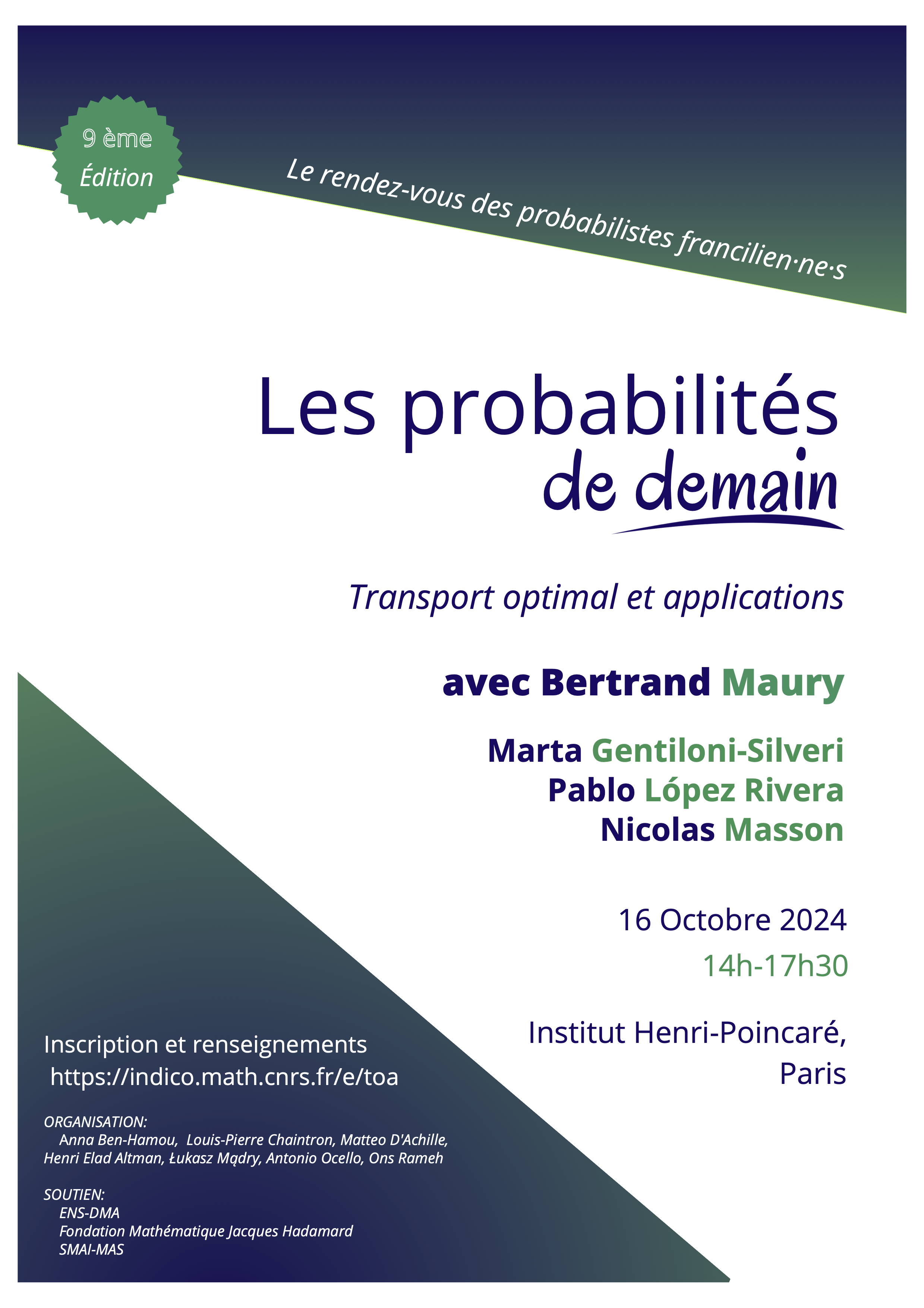Transport optimal et applications
Amphithéâtre Yvonne Choquet-Bruhat
Institut Henri Poincaré

-
-
14:00
→
15:00
Transport optimal et flots de gradient sous contrainte 1h Amphithéâtre Yvonne Choquet-Bruhat
Amphithéâtre Yvonne Choquet-Bruhat
Institut Henri Poincaré
11 rue Pierre et Marie CurieNous proposons une introduction au cadre du transport optimal, qui permet de définir une métrique sur l’espace des mesures de probabilité sur un espace métrique mesurable.
Cette métrique permet de donner un sens à la notion de flot de gradient, malgré l’absence de structure hilbertienne, et fournit un cadre théorique à un grand nombre d’équations d’évolution classiques, cadre qui privilégie une vision lagrangienne des choses, par opposition à la vision eulérienne traditionnelle.
Nous donnerons une vue d’ensemble de ce cadre théorique, et montrerons comme il permet de traiter des équations difficilement abordables d’un point de vue eulérien, en particulier pour des modèles macroscopiques de mouvements de foules sous contrainte de congestion.Orateur: Prof. Bertrand Maury (LMO, Université Paris-Saclay et DMA, Ecole Normale Supérieure) -
15:00
→
15:30
Pause café (longue) 30m Bâtiment Borel
Bâtiment Borel
Institut Henri Poincaré
11 rue Pierre et Marie Curie -
15:30
→
16:00
Diffusion Flow Matching models and their connection with Entropic Optimal Transport 30m Amphithéâtre Yvonne Choquet-Bruhat
Amphithéâtre Yvonne Choquet-Bruhat
Institut Henri Poincaré
11 rue Pierre et Marie CurieDiffusion Flow Matching (DFM) models provide a powerful framework for generative modeling, and recent research suggests their connection to the entropic optimal transport (EOT) problem. In this talk, I will focus on the theoretical foundations of DFMs, their connections with EOT, and present novel non-asymptotic guarantees for these models. Specifically, I will discuss how, under mild assumptions on the target and auxiliary distributions, we establish bounds on the Kullback-Leibler divergence between the generated and target distributions when using as bridge the conditional distribution associated with the Brownian motion. Joint work with Giovanni Conforti and Alain
DurmusOrateur: Marta Gentiloni Silveri (SIMPAS, CMAP, École polytechnique) -
16:00
→
16:15
Pause café (courte) 15m Bâtiment Borel
Bâtiment Borel
Institut Henri Poincaré
11 rue Pierre et Marie Curie -
16:15
→
16:45
Lipschitz regularity of transport maps and its connection with functional inequalities 30m Amphithéâtre Yvonne Choquet-Bruhat
Amphithéâtre Yvonne Choquet-Bruhat
Institut Henri Poincaré
11 rue Pierre et Marie CurieFunctional inequalities (Poincaré, log-Sobolev, etc.) represent a ubiquitous tool in probability, since they help us to quantify the convergence to equilibrium of ergodic Markov processes and imply good concentration properties of a probability measure, among other properties. It is natural to wonder if these inequalities remain valid if we perturb the measure. It is known that if there exists a globally Lipschitz map pushing forward the source measure towards its perturbation, then it is easy to transport certain functional inequalities. For example, Caffarelli’s contraction theorem states that the optimal transport map between the Gaussian measure and a log-concave perturbation has the desired Lipschitz regularity.
How could Caffarelli's theorem be extended? Is it possible to do this in more general spaces? Is the optimality of the transport map necessary for this purpose? In this talk I will partially answer to these questions: I will show how a Lipschitz transport map exists if we consider log-Lipschitz perturbations of a measure on a Riemannian manifold, via an alternative to the optimal transport map, induced by the Langevin diffusion associated to the source measure (aka Kim-Milman’s heat flow transport map).
Orateur: Pablo López Rivera (Laboratoire Jacques-Louis Lions, Université Paris Cité) -
16:45
→
17:00
Pause café (courte) 15m Bâtiment Borel
Bâtiment Borel
Institut Henri Poincaré
11 rue Pierre et Marie Curie -
17:00
→
17:30
Optimal transport tools for PDEs : the example of macroscopic crowd motion models 30m Amphithéâtre Yvonne Choquet-Bruhat
Amphithéâtre Yvonne Choquet-Bruhat
Institut Henri Poincaré
11 rue Pierre et Marie CurieIn 1998, Jordan, Kinderlehrer and Otto proposed an approximation scheme for the Fokker-Planck equation that gives a very elegant interpretation of this PDE as a gradient flow in a certain metric space : the Wasserstein space. Thanks to this publication, the PDE community discovered a way of using optimal transport tools and gradient flow theory for a large class of PDEs, raising a certain interest for what has been referred to as the JKO scheme ever since. However, it appears that the historical examples of PDEs that first were interpreted as a gradient flow in the Wasserstein space - such as the Fokker-Planck equation or the heat equation - do not require for their study to been seen as such, raising the question of the use of this interpretation. During this talk, we will focus on the specific example of certain crowd motion models that yield some new type of PDEs, for which the JKO approach allowed a huge breakthrough.
Orateur: Nicolas Masson (Laboratoire de Mathématiques d’Orsay, Université Paris-Saclay and Institut Camille Jordan, Université Claude Bernard - Lyon 1)
-
14:00
→
15:00
